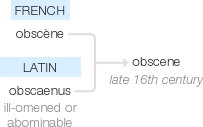Obscene
late 16th century: from French obscène or Latin obscaenus ‘ill-omened or abominable’.
wiktionary
From Middle French obscene (modern French obscène(“indecent, obscene”)), and from its etymonLatin obscēnus, obscaenus(“inauspicious; ominous; disgusting, filthy; offensive, repulsive; indecent, lewd, obscene”). The further etymology is uncertain, but may be from ob-(prefix meaning ‘towards’) + caenum(“dirt, filth; mire, mud”) (possibly ultimately from Proto-Indo-European *ḱweyn-(“to make dirty, soil; filth; mud”)) or scaevus(“left, on the left side; clumsy; (figurative) unlucky”) (from Proto-Indo-European *skeh₂iwo-). [1]
etymonline
obscene (adj.)
1590s, "offensive to the senses, or to taste and refinement," from French obscène (16c.), from Latin obscenus "offensive," especially to modesty, originally "boding ill, inauspicious," a word of unknown origin; perhaps from ob "in front of" (see ob-) + caenum "filth."
The meaning "offensive to modesty or decency, impure, unchaste" is attested from 1590s. Legally, "any impure or indecent publication tending to corrupt the mind and to subvert respect for decency and morality." In modern U.S. law, the definition hinged on "whether to the average person, applying contemporary community standards, the dominant theme of the material taken as a whole appeals to a prurient interest." [Justice William Brennan, "Roth v. United States," June 24, 1957]; this was refined in 1973 by "Miller v. California":
The basic guidelines for the trier of fact must be: (a) whether 'the average person, applying contemporary community standards' would find that the work, taken as a whole, appeals to the prurient interest, (b) whether the work depicts or describes, in a patently offensive way, sexual conduct specifically defined by the applicable state law; and (c) whether the work, taken as a whole, lacks serious literary, artistic, political, or scientific value.
Related: Obscenely.
